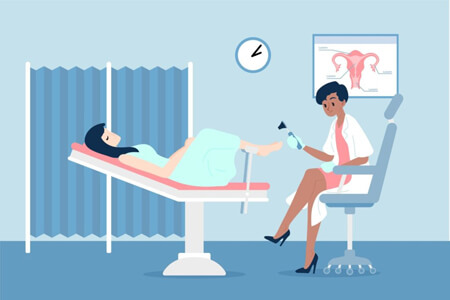- Video: Answers to Common Gynecological Problems
- Causes of gynecological diseases
- Video: Common Gynec Problems in Women
- Main symptoms
- Video: GYNECOLOGIC EXAMINATION, Causes, Signs and Symptoms, Diagnosis and Treatment.
- Women's diseases (in three groups)
- Video: Gynaecology - Infertility in Women (causes and pathophysiology)
- Video: Women's Health: Gynecology
- Video: Common gynaecological problems every women and girls should know with solutions
- Video: 5 Most Common Gynecological Problems Every Women Must Know
- Prevention of gynecological diseases
- Video: 5 Most Common Gynecological Problems in Women
- Rate the author (2)
- Comments (2)
There are many gynecological diseases that can occur in women. Some of them include:
- Vaginal infections such as vaginitis, candidiasis and trichomoniasis
- Inflammatory diseases such as endometritis, salpingitis and oophoritis.
- Uterine fibroids, which are benign tumors.
- Cervical cancer, which can be life-threatening.
- Polyps in the uterus or on the cervix.
- Various menstrual disorders such as amenorrhea, dysmenorrhea and metrorrhagia.
- Endometriosis, which is characterized by the growth of tissue, usually on the walls of the uterus, outside of it.
- Pathologies of the mammary glands, such as mastopathy and breast cancer.
- Ovarian pathologies such as ovarian cysts and ovarian cancer.
- Sexual dysfunction, such as sexual dysfunction and infertility.

It is important to see a gynecologist at the first sign of any of these conditions, as early detection and treatment can prevent serious consequences. Regular examinations by a gynecologist will also help maintain the health of the female reproductive system and prevent the development of many diseases.
So, types of gynecological diseases in women - further in our article.
Video: Answers to Common Gynecological Problems

Causes of gynecological diseases
Gynecological problems in women can be caused by a variety of causes, including:
- Sexually transmitted infections such as chlamydia, gonorrhea, trichomoniasis, human papillomavirus (HPV), herpes and others.
- Hormonal imbalances such as thyroid dysfunction, polycystic ovaries, menopause, and other conditions.
- Immune system disorders that can lead to the development of autoimmune diseases such as vulvovaginitis, vulvar lyken flatus, Still's syndrome, and others.
- Mechanical damage, such as when using tampons, showers or other instruments that can cause injury to the vagina or cervix.
- Heredity and genetic factors that may increase the risk of developing certain diseases, such as ovarian or breast cancer.
- Unhealthy lifestyle, including poor diet, lack of physical activity, drinking and smoking.
- Stress and psychological problems that can affect hormonal balance and the immune system, as well as lead to a decrease in the body's resistance to infections.
- Incorrect treatment or self-medication, which can lead to the development of complications and deterioration.
It is important to remember that many gynecological diseases can be prevented by proper lifestyle, regular medical examinations and timely treatment.
You may be interested in information about how to understand that you have inflammation of the appendages - read our other article.
Video: Common Gynec Problems in Women

Main symptoms
The main symptoms of gynecological diseases in women can be:
- Pain in the lower abdomen or pelvis
- Menstrual irregularities such as painful or irregular periods
- Unusual vaginal discharge, such as a strong odor or color change
- Itching or irritation in the genital area
- Pain during intercourse
- Swelling or tenderness of the mammary glands
- Unexplained tiredness or weakness
- Fever or fever
However, symptoms may vary depending on the specific disease.
You may be interested in information on the topic what to do with cervical erosion - read our other article.
Video: GYNECOLOGIC EXAMINATION, Causes, Signs and Symptoms, Diagnosis and Treatment.

Women's diseases (in three groups)
Female gynecological diseases can be divided into three groups:
- Inflammatory diseases are diseases that cause inflammation in various areas of the female reproductive system, such as the vagina, cervix, fallopian tubes, or ovaries. These include diseases such as vaginitis, cervicitis, salpingitis, oophoritis, etc.
- Hormonal diseases are diseases that are associated with a violation of the hormonal balance in a woman's body. These include diseases such as endometriosis, polycystic ovary syndrome, mastopathy, etc.
- Tumors are diseases that are associated with the formation of tumors in the female reproductive system. These include diseases such as uterine fibroids, cervical cancer, ovarian cancer, and others.
Each of these groups of diseases has its own characteristic symptoms and methods of treatment, so it is important to consult a gynecologist for an accurate diagnosis and appropriate treatment.
Bartolinitis
Bartolinitis is an inflammation of the Bartholin glands, which are located in the pelvic lips in women. These glands produce a secretion that helps lubricate the vagina and provide comfort during intercourse.
The cause of Bartholinitis can be stagnation of secretion in the gland, which can occur due to infection, trauma, or blockage of the duct of the gland. Some of the more common causes include a bacterial infection such as chlamydia or gonorrhea, as well as other infections caused by bacteria, viruses, or fungi.
Also, the risk of developing Bartholinitis increases with poor hygiene, as well as with weakened immunity, which can occur due to stress, pregnancy, illness, or treatment with certain medications.
Symptoms of Bartholinitis may include painful swelling of the pelvic lips, pain when walking and sitting, burning and itching in the vaginal area, and vaginal discharge. Treatment for Bartholinitis may include antibiotics, warm compresses, and, in rare cases, drainage or surgical removal of the gland.
Video: Gynaecology - Infertility in Women (causes and pathophysiology)

Vaginitis
Vaginitis is an inflammation of the vagina, which can be caused by various reasons. This is a common disease in women, which can manifest itself with various symptoms.
Vaginitis can be caused by a bacterial, viral, or fungal infection. Some of the more common types of vaginitis include bacterial vaginosis, candidiasis (thrush), and trichomoniasis. These infections can be sexually transmitted, but can also occur in women who do not have sex.
Other causes of vaginitis may include an allergic reaction to hygiene products such as soap or shower gel, use of certain birth control or antibiotics, and changes in hormone levels during pregnancy, menopause, or when using hormone therapy.
Symptoms of vaginitis may include itching, burning, and irritation in the vaginal area, vaginal discharge, odor, and pain during intercourse and urination. Treatment for vaginitis depends on its cause and may include antibiotics, antimycotics, or anti-inflammatory drugs.
Vulvitis
Vulvitis is an inflammation of the vulva, that is, the external genitalia in women. This disease can be caused by various reasons.
One of the most common causes of vulvitis are infections such as bacterial, viral or fungal infections. Some of the infections that can cause vulvitis include herpes, chlamydia, gonorrhea, and candidiasis. Vulvitis can also be caused by an allergic reaction to hygiene products such as soap or shower gel, or to materials used in underwear.
Other causes of vulvitis can include trauma to the vulva, such as prolonged rubbing or wearing tight clothing, and changes in hormone levels during pregnancy, menopause, or when using hormone therapy.
Vulvitis symptoms may include itching, burning and irritation in the vulva, redness of the skin, pain during intercourse and urination. Treatment for vulvitis depends on its cause and may include antibiotics, antimycotics, anti-inflammatory drugs, or changes in hygiene and dressing.
Video: Women's Health: Gynecology

Vulvovaginitis
Vulvovaginitis is an inflammation of the vulva and vagina at the same time. This disease can be caused by various reasons.
One of the most common causes of vulvovaginitis are infections such as bacterial, viral or fungal infections. Some of the infections that can cause vulvovaginitis include herpes, chlamydia, gonorrhea, candidiasis, and trichomoniasis. Vulvovaginitis can also be caused by an allergic reaction to hygiene products such as soap or shower gel, or to materials used in underwear.
Other causes of vulvovaginitis may include trauma to the vulva or vagina, such as prolonged friction or tight clothing, and changes in hormone levels during pregnancy, menopause, or hormone therapy.
Symptoms of vulvovaginitis may include itching, burning, and irritation in the vulva and vagina, redness of the skin, pain during intercourse and urination, and vaginal discharge.
Treatment for vulvovaginitis depends on its cause and may include antibiotics, antimycotics, anti-inflammatory drugs, changes in hygiene and dressing.
Adnexitis
Adnexitis is an inflammation of the ovaries and / or fallopian tubes in women. This is a common condition that can cause serious complications, including infertility and chronic lower abdominal pain.
The causes of adnexitis can be different. One of the most common causes is infections such as chlamydia or gonorrhea, which can invade the ovaries and fallopian tubes and cause inflammation. There may also be other infections caused by bacteria, viruses or fungi.
Other possible causes of adnexitis may include trauma or damage to the ovaries or fallopian tubes, as well as a number of medical procedures such as abortion or intrauterine contraception.
It is important to remember that adnexitis can be a serious condition that requires medical attention. If you have symptoms of adnexitis, such as pain in the lower abdomen, fever, nausea or vomiting, seek help from a gynecologist for diagnosis and treatment.
Video: Common gynaecological problems every women and girls should know with solutions

Endocervicitis (cervicitis)
Endocervicitis, also known as cervicitis, is an inflammation of the endocervix, the inner lining of the cervix in women. It is a common condition that can lead to various symptoms such as soreness during intercourse, vaginal discharge, and dysmenorrhea (painful menstruation).
The causes of cervicitis can be different. One of the most common causes is infections such as chlamydia and gonorrhea, which can cause inflammation of the cervix. There may also be other infections caused by bacteria, viruses or fungi.
Other possible causes of cervicitis may include damage to the cervix during childbirth or abortion, or the use of certain types of contraception, such as a diaphragm or coil.
It is important to remember that cervicitis can be a serious condition that requires medical intervention. Treatment for cervicitis usually includes antibiotics and other medical treatments depending on what caused the inflammation.
Endometritis
Endometritis is an inflammation of the endometrium, the inner layer of the uterus in women. It is a common condition that can lead to various symptoms such as painful periods, vaginal discharge and fever.
The causes of endometritis can be different. One of the most common causes are infections, such as bacterial infections, which can enter the uterus and cause inflammation. There may also be other infections caused by viruses or fungi.
Other possible causes of endometritis may include damage to the uterus during childbirth or abortion, and the use of certain types of contraception, such as an intrauterine device.
It is important to remember that endometritis can be a serious condition that requires medical attention. Endometritis treatment usually includes antibiotics and other medical treatments depending on what caused the inflammation.
Adhesions (adhesive disease) — cause of infertility
Adhesions, or adhesive disease, are the formation of ligaments or adhesions between various organs or tissues within the body. It can occur in various parts of the body, but in gynecology, adhesions can form in the pelvic area in women.
The causes of adhesive disease can be different. One of the most common causes are inflammatory diseases such as endometritis, adnexitis, cervicitis and others. Inflammation can cause adhesions to form between various organs or tissues in the body.
Other possible causes of adhesive disease may include trauma, pelvic surgery, radiation therapy, and other factors that can damage tissue within the body.
It is important to remember that adhesive disease can lead to serious complications such as infertility, pelvic pain and other health problems. Treatment may include medication, surgery, or other medical procedures, depending on the cause of the adhesions.
Cervical erosion
Cervical erosion (CER) is a condition where the top layer of cervical tissue (epithelium) becomes thinner or disappears, which can result in red or bright pink tissue being exposed. ESM often causes no symptoms, but may cause increased vaginal discharge or light bleeding after intercourse or a Pap test.
Causes of ESM may include:
- infections such as chlamydia or gonorrhea;
- hormonal changes, such as those that occur during pregnancy or when using hormonal contraceptives;
- trauma or various medical procedures such as abortions or biopsies;
- tobacco smoking.
ESM can resolve on its own, but in some cases, treatment may be required, including the use of cryotherapy (freezing), electrocoagulation (use of high frequency current), or drugs such as acid-based drugs. In any case, if you suspect ESM, it is important to see a gynecologist for diagnosis and treatment.
Uterine fibroids
Uterine fibroids are benign tumors that usually develop in the muscle tissue of the uterus. For most women, fibroids do not cause symptoms, but in some cases, they can lead to painful or unusual periods, pain in the lower abdomen, painful intercourse, or problems with pregnancy.
The reasons for the development of uterine fibroids are not entirely clear, but it is known that it is associated with hormonal changes in a woman's body. Specifically, fibroids can develop when levels of estrogen, a hormone produced by the ovaries during the first half of the menstrual cycle, are high. Risk factors that may increase the chance of developing fibroids include:
- heredity;
- early start of the menstrual cycle;
- late onset of menopause;
- obesity;
- high blood pressure.
Uterine fibroids can be diagnosed using ultrasound or magnetic resonance imaging. Treatment for fibroids may include observation if the tumor is small and causing no symptoms, or surgical removal of the tumor if it is large or causing severe symptoms. In some cases, the use of hormonal drugs to reduce the size of the tumor may be recommended. If you suspect uterine fibroids, it is important to see a gynecologist for diagnosis and treatment.
Ovarian cyst or tumor
An ovarian cyst is a fluid-filled cavity that usually develops on or inside the ovary. For most women, ovarian cysts cause no symptoms and go away on their own, but in some cases, cysts can be large or cause symptoms such as lower abdominal pain, unusual periods, or painful intercourse.
Causes of ovarian cysts may include:
- changes in hormone levels such as estrogen and progesterone;
- Irregularities in the process of the egg, such as the inability of the egg to reach the ovary;
- heredity;
- trauma or various medical procedures, such as pelvic surgery.
An ovarian tumor is an abnormal growth of cells in the tissue of the ovary that can be either benign or malignant (ovarian cancer). An ovarian tumor can cause symptoms such as lower abdominal pain, bloating, changes in urination or rectal bleeding.
The reasons for developing an ovarian tumor are not well understood, but it is known that certain factors can increase the risk of developing it, such as:
- presence of ovarian cysts;
- heredity;
- late onset of menopause;
- fertility treatment;
- use of hormonal contraceptives.
Different methods, such as ultrasound or magnetic resonance imaging, can be used to diagnose ovarian cysts and ovarian tumors. Treatment may vary depending on the type and size of the tumor, but may include observation, surgical removal of the tumor, or drug treatment.
Persistent menstrual irregularity
Persistent menstrual irregularities are changes in the regularity, duration, or amount of bleeding during menstruation in women. This can occur both due to physiological causes such as pregnancy or menopause, or due to various diseases such as polycystic ovaries, hyperprolactinemia, thyroid gland, anorexia, obesity or endometriosis.
- Polycystic ovary syndrome is a condition in which the ovaries produce too many male hormones, which can lead to cysts and menstrual irregularities.
- Hyperprolactinemia is a condition in which the level of prolactin in the blood is elevated, which can lead to menstrual irregularities and hormonal changes.
- Thyroid disorders can cause both hyperthyroidism and hypothyroidism, which can lead to changes in the menstrual cycle.
- Anorexia and obesity can also affect the menstrual cycle, as they can lead to changes in hormone levels in the body.
- In addition, endometriosis is a condition in which tissue that normally grows inside the uterus begins to grow outside of it, which can lead to painful and irregular periods.
Treatment may include lifestyle changes, such as diet changes or increased physical activity, as well as medications, such as thyroid medications or hormonal contraceptives, that can help stabilize the menstrual cycle.
Video: 5 Most Common Gynecological Problems Every Women Must Know

Prevention of gynecological diseases
There are several ways to prevent gynecological diseases:
- Regular visits to the gynecologist: Women should visit the gynecologist at least once a year for preventive examinations and examinations.
- Proper hygiene: Women should take care of the hygiene of their genitals, shower regularly and use gentle hygiene products.
- Using condoms: Using condoms can help prevent the spread of infections that can cause gynecological problems.
- Healthy lifestyle: A healthy lifestyle that includes a healthy diet, regular physical activity, and not smoking can help prevent some gynecological diseases.
- Use of hormonal contraceptives: The use of hormonal contraceptives may help prevent the development of some gynecological diseases, such as endometrial and ovarian cancer.
- Regular cancer screening: Regular cancer screenings can help detect gynecological diseases at an early stage, which increases the chances of a complete cure.
- A good sex life: A good sex life, including the use of condoms, can help prevent the spread of infections that can cause gynecological diseases.
Video: 5 Most Common Gynecological Problems in Women


















Comments (2)